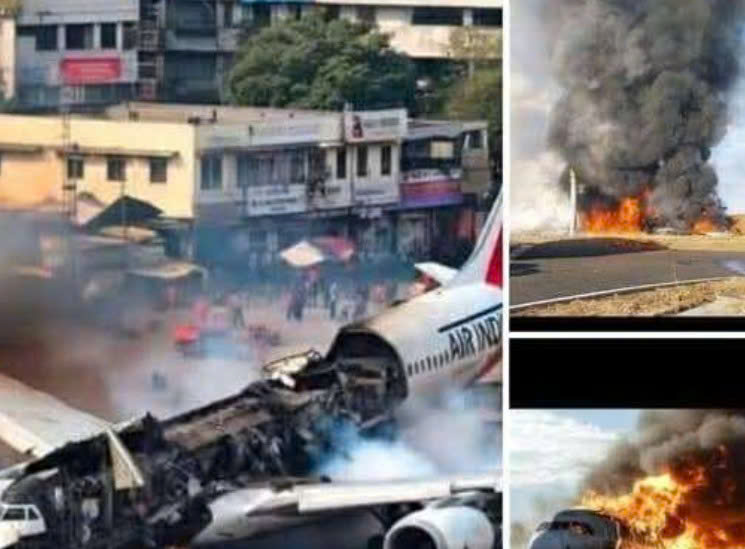It was supposed to be a routine afternoon flight connecting Ahmedabad to London Gatwick—a journey made countless times before by Air India’s reliable Boeing 787 Dreamliner fleet. But on June 12, 2025, Flight AI171 turned into a heartbreaking tragedy that has shaken an entire nation and reignited questions about aviation safety, emergency preparedness, and accountability. What began as an ordinary takeoff ended within minutes in chaos, fire, and unimaginable loss.

The aircraft, carrying 230 passengers and 12 crew members, departed Ahmedabad shortly after 1:00 PM. According to aviation officials, the takeoff appeared smooth at first, but just minutes later, the situation changed dramatically. Around 1:10 PM, Air India Flight AI171 reportedly went down near Ghoda Camp—a densely populated area located between Meghaninagar and the Ahmedabad Cantonment zone. Witnesses described hearing loud blasts followed by thick, dark smoke rising from the crash site. The pilot had issued a rare Mayday distress signal moments before impact, a sign that something catastrophic had unfolded in the air. The nature of that emergency, however, remains unclear.
Local residents near the area recounted scenes of horror and confusion. Some said they heard what sounded like an explosion, while others saw the plane descending rapidly, trailing smoke before it disappeared behind buildings. Emergency sirens echoed across the city as firefighters, police, and medical personnel raced to the site. The impact, according to early reports, caused widespread damage to homes and vehicles nearby, making rescue efforts even more challenging. Heavy smoke and debris hindered visibility as responders fought to contain fires and search for survivors. Sadly, initial assessments from officials indicated that all 242 people onboard were feared lost.
In the aftermath, Air India released an official statement confirming the tragic incident: “Flight AI171, scheduled from Ahmedabad to London Gatwick, encountered a serious event shortly after departure. We are working urgently to gather complete details and will provide updates as they become available.” The airline pledged full cooperation with authorities and emphasized that assisting families and providing accurate information would remain their top priority.
Air India Chairman N. Chandrasekaran expressed deep sorrow and solidarity with the victims’ families. “We are profoundly heartbroken by the loss of Flight AI171,” he said in an emotional statement. “Our thoughts are with every family and loved one affected by this devastating tragedy. We are coordinating closely with local and international authorities to ensure full support and transparency throughout the investigation.”
The Indian Prime Minister and senior government officials also expressed condolences, vowing that no effort would be spared in uncovering the truth behind the crash. Flags were flown at half-staff across the country, and moments of silence were observed in airports and parliament halls to honor the victims.
As the nation grieves, investigators are now focused on the pilot’s distress signal—the Mayday call that may hold the key to understanding what happened in the crucial final moments of the flight. A Mayday is only declared under the most severe conditions, such as a major mechanical failure, cabin decompression, or loss of control. Experts believe that the recovered black box and flight data recorders will be essential in determining whether a technical malfunction, weather issue, or human error was to blame.
The Directorate General of Civil Aviation (DGCA) immediately dispatched a full investigative team to the scene. Given the aircraft’s international route and manufacturer, both Indian and international aviation safety agencies, including Boeing representatives, are expected to assist in the probe. Authorities have already recovered sections of the fuselage and engine parts from the crash zone, which are being analyzed for clues about what triggered the sudden descent.
For the families waiting for answers, every minute feels like an eternity. At Ahmedabad Airport, relatives gathered in designated waiting areas, holding photographs and praying for news. Air India staff and crisis counselors provided emotional support as names were confirmed and information trickled in. Grief filled the terminals as news channels across India covered the tragedy continuously, their headlines reflecting a nation’s heartbreak and disbelief.
Witnesses from the crash site described acts of courage amid the chaos. Local residents rushed toward the flames with buckets of water and makeshift stretchers, while firefighters and paramedics worked tirelessly to contain the blaze and secure the area. The sense of solidarity among first responders and civilians became a small light in an otherwise dark day for the nation.
In the coming days, the investigation will focus heavily on three critical elements: the Mayday call, the aircraft’s maintenance records, and the flight crew’s communication logs. Aviation specialists caution that it may take weeks—possibly months—before the final report is released. Still, early recovery of both black boxes provides hope for a clearer understanding of what went wrong.
While Air India’s safety record has improved significantly in recent years, this disaster has once again underscored the unpredictable nature of air travel. Aviation experts stress that transparency and accountability are crucial to restoring public confidence. “Every crash teaches us something,” said one retired pilot interviewed by a national news network. “But this one feels personal for India. It reminds us that safety can never be taken for granted.”
As rescue teams continue their work, the crash site has been cordoned off, with debris carefully documented and collected. Government officials have promised compensation and long-term support for affected families. Across India, vigils and candlelight memorials have begun—communities coming together to mourn those who never made it to their destination.
By evening, Air India had updated its website with emergency helpline numbers and details for relatives seeking information. Social media platforms flooded with messages of sympathy, solidarity, and grief. Many shared stories of loved ones who were on board—students, business travelers, newlyweds, and crew members who had served the airline for decades.
As the sun set over Ahmedabad that day, smoke still lingered in the sky, a painful reminder of how quickly ordinary life can be shattered. The loss of Air India Flight AI171 will be remembered not only as an aviation disaster but also as a call to strengthen the systems meant to protect lives. The voices of those lost will echo through every safety reform and every lesson learned from this tragedy.
While the investigation continues, officials urge the public to avoid speculation until verified information is released. Air India has pledged full transparency and cooperation with both national and international authorities. For now, a nation mourns—grieving not just the 242 souls lost, but the trust, safety, and sense of certainty that vanished with them.
In a country that has endured its share of triumphs and tragedies, the memory of Flight AI171 serves as a somber reminder: behind every flight number are human stories, and behind every tragedy, a duty to seek truth, justice, and change.




